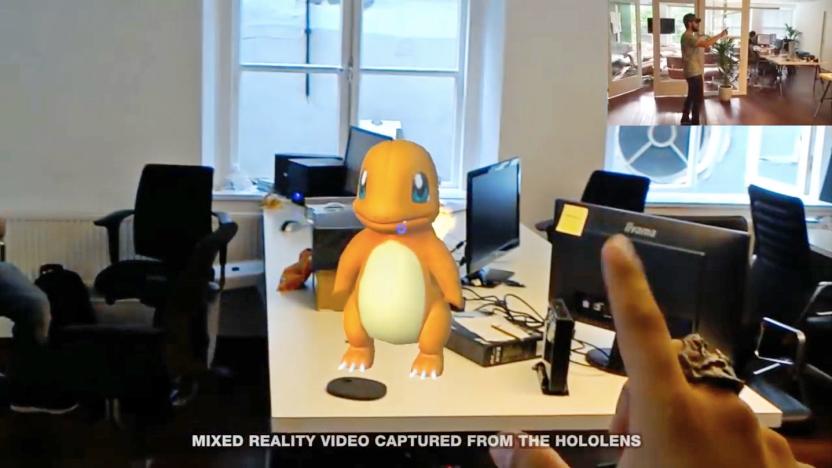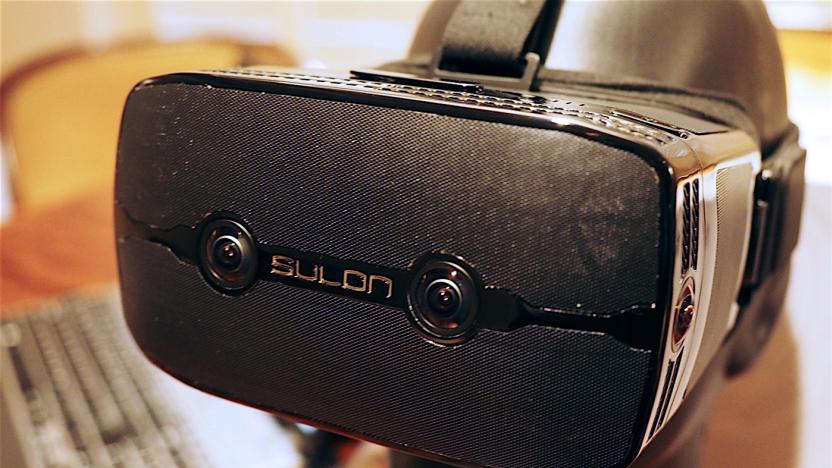mixedreality
Latest

Microsoft launches Actiongram on HoloLens with a tiny George Takei
Ever wanted to hang out with a tiny, goofball celebrity? If you happen to have a HoloLens augmented reality headset, now you can. Today Microsoft made Actiongram, its mixed-reality filmmaking app, available to all HoloLens owners -- and celebrated the launch by giving users access to a hologram of George Takei.

Google is still working on a standalone headset
Yesterday Recode published an article suggesting Google has killed a VR project that would have directly competed with high-end headsets like the Oculus Rift. While it may be true that this particular project has been shuttered, sources within the company say that a Google team is still working on a dedicated headset that blurs the line between virtual reality and augmented reality.

'Pokémon Go' gets in your face with an unofficial HoloLens demo
With Pokémon Go fever gripping the nation, it was only a matter of time before someone took the game's augmented reality features and evolved them, as it were, with VR and mixed reality. And CapitolaVR has done just that, creating a Pokémon Go-esque demo with a Microsoft HoloLens.

NASA is building the next Mars rover in mixed reality
I poked my head inside NASA's latest Mars rover. During a mixed-reality demonstration at the Jet Propulsion Laboratory (JPL) in Pasadena, as soon as I strapped on a HoloLens, a vibrant holographic vehicle popped up in front of me.

Magic Leap reveals more about its 'mixed reality' tech
Despite billions in funding and board members like Peter Jackson and Sundar Pichai, there's still a lot of mystery around Magic Leap's augmented reality (AR) tech. We know that it's making a self-contained, high-resolution AR headset that seamlessly inserts digital elements into the real world, much like Microsoft's Hololens. We've also seen a patent application and a spectacular gaming concept video. However, the company has revealed a bit more new information about its vision for Magic Leap via a new demo video (below) and a feature article from Wired.

HTC Vive developer explains how to livestream 'mixed reality'
Mixed reality games -- which combine VR and AR -- are about to become very mainstream when the HTC Vive and Oculus Rift virtual reality headsets ship in just a few days. For Twitch streamers who want to do justice to the first wave of such games, there are myriad new technical challenges (and costs). Luckily, the team that brought the us the delightful mixed reality building game Fantastic Contraption has put together a guide on streaming in the new format.

The Sulon Q has insane mixed reality ambitions
Earlier this week, Sulon Technologies unveiled the Sulon Q, which it claims is the world's first tether-free all-in-one headset that combines AR, VR and spatial computing in a single device. That means that instead of attaching it to a computer, like the Oculus Rift or the HTC Vive, or relying on a smartphone, like the Gear VR, the Q is a computer in and of itself -- it even has a battery pack attached. Think of it as wearing a computer on your face. On top of that, it also has a multitude of sensors that promise real-time hand-tracking and environment mapping. It all seems a little far-fetched, which could explain why Sulon released a "Magic Beans" video to demo the tech (see below). We also took the opportunity to speak to Sulon CEO Dhan Balachand here at GDC 2016 and tried the (non-working) headset on our heads.

Immerse yourself in Vive's VR with two mixed-reality videos
Fantastic Contraption launches with the HTC Vive virtual reality headset on April 5th and it promises to take advantage of the technology's coolest features. It's a full-body kind of game that challenges you to craft objects that can overcome physical obstacles to reach specific points in the world. If that description doesn't excite you, take a look at these mixed-reality demo videos featuring Fantastic Contraption developer Colin Northway and get hype.

Microsoft's taking HoloLens on tour to woo developers
Microsoft has already said its mixed reality headset, HoloLens, will be reaching developers early next year. But while we wait for that to happen, the company plans to take it on tour across the US and Canada, in an event that's going to give developers the chance to try the device firsthand. They'll also be able to meet members of the HoloLens team and learn how to create holographic experiences, which is a smart way to lure in any dev who's thinking about paying the $3,000 for a test unit. The live demo trip begins October 13th in Seattle, followed by Toronto, Salt Lake City, Chicago, San Francisco, Los Angeles, New York City, Minneapolis, Phoenix, Atlanta and, lastly, Austin. To register, as well as find out the exact dates for each city, check out the event's dedicated site.

HoloLens 'Project XRay' lets you blast robot armies with a ray gun fist
Microsoft took time during today's Windows 10 Devices event to give the audience a more in-depth look at what its new HoloLens AR system is capable of. Minds were blown, jaws were dropped and more than a few digital robots were blown to smithereens during the 8-minute demo.

Microsoft demos 'Project XRay' mixed reality game for HoloLens
One of Microsoft's most exciting products to date is HoloLens, and today the company revealed a new mixed reality game for the headset called Project XRay. The title was developed internally, according to Executive VP of the Windows and Devices Group Terry Myerson. Similar to the Minecraft experience on HoloLens, Project XRay also looks incredible -- particularly because you can turn most any room into your own gaming canvas. Here, though, you're wearing a holographic weapon on your arm, which you'll need to defend yourself from an attack of flying robots. Once they crawl out of the walls, you can shoot lasers at them -- yes, lasers. "Holograms behave just like real objects; they can interact with environments and with each other," said the Microsoft representative on stage about Project XRay.

Magic Leap adds former Vevo CEO to its mysterious team
Magic Leap is as mysterious as it's ambitious. Ever since the Google-backed startup raised a whopping $542 million, it's been pegged as the next big thing in mixed reality. But apart from it being a platform that incorporates digital lightfield technology, little is known about the experience or the headset so far. What's known is that the company is building a rather unorthodox yet stellar team for its "techno-biology" mission. After appointing acclaimed sci-fi writer Neal Stephenson as the company's Chief Futurist late last year, the company has brought on Rio Caraeff, former CEO of Vevo, as its Chief Content Officer.

HoloLens is and isn't Xbox One's answer to PlayStation 4's virtual reality headset
Finally, we can stop asking Microsoft's Xbox lead Phil Spencer about virtual reality headsets. "For us, I think this is the area," Spencer told a group of interviewers at yesterday's Windows 10 event. He was responding to whether or not there's also a virtual reality headset in the works at Microsoft, just an hour after the company unveiled HoloLens: a "mixed reality" headset that enables the wearer to see holograms in real life. For Spencer, HoloLens is both Microsoft's alternate answer to the recent virtual reality explosion and a potential answer to Sony's Project Morpheus headset -- a VR peripheral that works with the PlayStation 4, where HoloLens could work with the Xbox One. "It's very cool. To me there's not a successful consumer electronics device on the planet where gaming is not a primary form of app category on the thing," Spencer said. There's even a "Minecraft-inspired" demo -- which answers that question -- for HoloLens that shows the implications of gaming with holograms. But no demo showed the headset working with the Xbox One in any capacity. Spencer instead talked around that possibility: "I think gaming will be important. Specific scenarios with the Xbox, we're thinking hard about. People could ask about streaming solutions. Could I use it as a display for my Xbox? We don't have answers to any of those things, but know it's all part of the same organization."

Canon previews a handheld version of its MREAL Mixed Reality tech at SIGGRAPH, we go hands-on (video)
As a complement to its MREAL Mixed Reality headset, Canon is showing off a handheld version of the technology this week at SIGGRAPH. The new version functions much like the head-mounted one, enabling the use of markers or (as was the case here) sensors to render images in real space. Something you'll want to keep in mind: this is still an enterprise-focused device. That said, it doesn't make the tech demo and usage scenarios any less cool to gawk at. The demonstration we saw here in Anaheim involved a Kabuki dancer out in the center of the demo area. Details like shadows and wrinkles in the performer's clothes were rendered in real time -- just as if a real person were performing. A collection of sensors mounted around the top of the demo stage allowed us to look around the space while the projected image reacted to our position. Not once did we lose sight of the action. Two other demos for the head-mounted display (that can easily translate to the handheld unit as well) caught our attention, too. First, a boat motor was projected in real space using augmented reality markers, allowing the user to inspect a scale model of the engine for training or other purposes. The ability to deconstruct the engine and see how different portions of it worked was all available to the user. Next, we saw a set of markers wrapping a rectangle projected a model of a Canon DSLR housing. Both of these scenarios offer a more in-depth look at 3D models before the prototyping phase or any steps are taken towards production. A quick look at the Kabuki demo and our best in-dance commentary awaits on the other side of the break. %Gallery-194606%

Canon MREAL Mixed Reality headset hitting US March 1st for $125,000
This isn't the first we've heard of Canon's Mixed Reality system -- not by a long shot. The company's trotted its augmented reality headset out a few times before. The camera maker did, however, take the opportunity to shed some light on its US plans for the head-mounted display yesterday at an event held in Manhattan's Classic Car Club. Surrounded by the classy convertibles, the company also unveiled the more streamlined (and vaguely Cypress Hill-esque) MREAL name. As before, the headset is decidedly industry-facing, targeting product prototypers with an augmented reality system that lets designers interact with computer-generated versions of their creations before actually willing them into existence. The MREAL System for Mixed Reality (that's the full name -- or, if you want to drill down even further: the headset is the HM-A1 and the software platform is MP-100) generates video of one's surroundings using a pair of cameras positioned in front of the wearer's eyes, which is combined with computer-generated graphics. The result is displayed on a pair of small monitors "to create high-impact, three-dimensional images." Amongst the potential target audiences for the product are automotive designers, manufacturers, university researchers and museum exhibit curators. Canon's also planning to open up its SDK to developers, so applications will likely only increase. As per Canon's press release, the MREAL system is set for a March 1st release, priced on a sliding scale, depending on which configuration you opt into -- though the company tossed out the steep $125,000 price point, along with $25,000 in annual maintenance. The aforementioned press release can be found after the break -- or better yet, have a look at our hands-on with the device right now.

Canon MREAL Mixed Reality headset hands-on (video)
Thought Google Glass cost a pretty penny? Well, try this head-mounted display on for size. It's that Mixed Reality wearable from Canon that we've been hearing so much about. As previously noted, it's set to hit the States the first of next month, carrying a decidedly gigantic $125,000 price tag (plus an estimated $25,000 in annual maintenance). But before you go writing a brashly worded letter to the bigwigs at Canon, remember: this isn't really for you. That is, unless you're an automotive manufacturer, research university or museum display curator. This is a heavy-duty, industry-facing device. That said, the camera maker did give a few of us non-industry folks the chance to play around with the display at an event in Manhattan last night, while the rest of the tech world was fawning over that fancy new PlayStation thingamabob. Having spent some time with Sony's HMZ-T1, we've got to say that the experience of wearing this far, far more high-end product wasn't all that different from a hardware perspective: slip it over your head, place it on the bridge of your nose and tighten. It's possible to get it snug without being too uncomfortable -- and when it's time to take it off, a flip of the lever will remove it in one go.

Canon shows how its Mixed Reality makes virtually anything look real (video)
Remember that Canon Mixed Reality project? For those torn between cold, hard real world, and the sickly sweet virtual one? Due for release this month, Canon's been showing off its purpose-built HMD in real (or is it virtual?) use to DigInfo. Using those stereo cameras and a "free-curve" prism -- along with high-speed image processing -- we get a glimpse at how it generates life-size virtual objects in real-time. While this could benefit a number of scenarios, Canon points to industrial design, where mock-ups are commonly used. This system allows designers to run through virtual versions first, before committing to more time intensive physical models. Working on something where this could be handy? Canon also says there will be an SDK for developers coming soon. Head past the virtual break for the real video tour.

Canon overhauls Mixed Reality platform with new head-mounted display
Canon's been fiddling around with augmented (or mixed) reality for some time now, but the company just took things to the next level. A new AR headset announced today is less stylish than that other soon-to-be-released wearable tech you've likely heard about, yet certainly more sophisticated than its bigger brother. The controller sees visual markers through dual on-board cameras and projects virtual objects onto two corresponding displays set right above the eyes, marrying the virtual world to the desert of the real. You can gaze from any angle and even manipulate the virtual projects with what looks to be a plastic, magic ice cream cone. The glasses are set to release next month and, while Canon hasn't assigned a price, all the planned applications are decidedly industrial, making us think they won't be cheap. So, you probably won't be using em' to scope out the various Layars around your hood.

Video: D-Touch drum machine keeps heads, hands bobbing
Oh sure, we've seen countless drum machine hacks over the years, but there's just something special about one that's so simple, yet so fulfilling. D-Touch is hailed as a visual markers recognition system "that enables the development of low-cost tangible user interfaces and mixed reality applications," and here, we're seeing it used to create movable sounds. Users simply print out the cubes, fold 'em up, add lentils and arrange them on the highly sophisticated A4 sheet of paper. We get the feeling this one won't cost you much to replicate, so why not hit the read link for more instructions after digging into the vid just beyond the break?[Via Engadget German]

Canon gets all 'Steve Zissou' with its Mixed Reality Aquarium
In some ways, augmented reality is an elegant solution to the main problem with VR: while there are some areas where insane levels of immersion are required, this stuff ain't cheap -- relegating solutions like CirculaFloor to academics, the military, and the extremely well-heeled. But how about those who just want to see wild graphics while they, you know, "party?" Canon's Mixed Reality Aquarium headset transforms any area you inhabit into a giant fishbowl. Not the sort of thing that you'll want to do more than once, probably -- although, to the company's credit, this is more of a research project than an actual product. How about an option to swim with Daryl Hannah from Splash? That would be pure gadget gold. That said, this does make for a fun video -- which we've graciously provided for you, after the break.[Via Oh Gizmo!]













